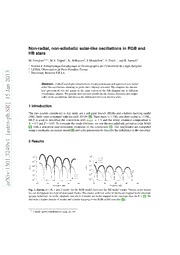
Non-radial, non-adiabatic solar-like oscillations in RGB and HB stars PDF
Preview Non-radial, non-adiabatic solar-like oscillations in RGB and HB stars
Non-radial, non-adiabatic solar-like oscillations in RGB and HB stars M.Grosjean1,3,a,M.A.Dupret1,K.Belkacem2,J.Montalban1,A.Noels1,andR.Samadi2 1 Institutd’AstrophysiqueGe´ophysiqueetOceanographiedel’Univertiste´deLie`ge,Belgium 2 LESIA,ObservatoiredeParis-Meudon,France 3 3 Doctorant,BoursierF.R.I.A. 1 0 2 Abstract. CoRoTandKeplerobservationsofredgiantsrevealrichspectraofnon-radial n a solar-likeoscillationsallowingtoprobetheirinternalstructure.Wecomparethetheoret- J ical spectrum of two red giants in the same region of the HR diagram but in different evolutionaryphases.Wepresenthereourfirstresultsonthe inertia,lifetimesandampli- 5 1 tudesoftheoscillationsanddiscussthedifferencesbetweenthetwostars. ] R 1 Introduction S . The two modelsconsideredin this study are a red giantbranch (RGB) anda helium burningmodel h p (HB).BothwerecomputedwiththecodeATON[9].Theirmassis1.4M⊙ andtheirradiusis11.9R⊙. - MLT is used to described the convection with αMLT = 1.9 and the initial chemical composition is o X =0.7andZ =0.02.Tocomputethemodelifetimes,weusethenon-adiabaticpulsationcodeMAD r [2] with a non-local time-dependant treatment of the convection [4]. The amplitudes are computed t s usingastochasticexcitationmodel[8]andsolarparameterstodescribetheturbulenceintheenvelope. a [ 1 2 Results v 9 4 2 3 . 100 100 1 l =0 0 10-1 10-1 ll ==12 :13 Inertia 1100--32 Inertia 1100--32 v i 10-4 l = 0 10-4 X l = 1 10-5 l = 2 10-5 r a 25 30 35 40 45 25 30 35 40 45 Frequency (µHz) Frequency(µHz) Fig.1.Inertiaofl=0,1and2modesfortheRGBmodel(left)andtheHBmodel(right).Thankstotheinertia wecandistinguishtwotypeofnon-radialmodes.Themodeswithlowvalueofinertiaaretrappedintheenvelope (p-typebehavior).Asintheadiabaticcasethel=2modesarebettertrappedintheenvelopethanthel=1[5].We alsonoteahigherdensityofmodesandabettertrappingintheRGBmodel(seealso[6]). a e-mail:[email protected] EPJWebofConferences 4 l = 0 3 l = 1 2 l = 2 1000 Lifetime (days) 10092 Lifetimes(days) 1006246 l =0 8 4 7 l =1 6 2 l =2 25 30 35 40 45 25 30 35 40 45 Frequency (µHz) Frequency(µHz) Fig. 2. Lifetimes of l=0, 1 and 2 modes for the RGB model (left) and the HB model (right). The oscillatory behaviorofthelifetimeintheHBmodelcomesfromtheoscillationsoftheinertia.Itisnolongerpresentinthe RGBmodelduetoahighradiativedampingforallmodesnottrappedintheenvelope. 1.6 1.4 l =0 l =1 1.4 1.2 l =2 Amplitudes (m/s) 11000.....20864 lll === 012 Amplitudes(m/s) 1000....0864 0.2 0.2 0.0 0.0 25 30 35 40 45 25 30 35 40 45 Frequency (µHz) Frequency(µHz) Fig.3.Amplitudesofl=0,1and2modesfortheRGB(left)andtheHB(right)models.Becauseoflargerradiative damping(leftpanels)andlargerinertia(rightpanels)ofl=1modestrappedintheenvelope,theiramplitudesare smallerthanthecorrespondingl=2andl=0modes.Thel=1tol=0amplitudesratiosaresmallerfortheRGBdue totheimportantradiativedamping.Thisresultsisnotincompatiblewithcurrentobservations[7]. 3 Conclusions Asalreadyfoundbyadiabaticcomputations[5],thespectrumdensityislargerintheRGBmodel.Lifetimesand amplitudesindicatethatmoreg-dominatedmixed-modesshouldmorebevisibleintheHBthanintheRGBmodel. ThisisduetoabettertrappingefficiencyintheRGBmodel(see[5])whichresultsfromitslargerdensitycontrast. Computationsoflifetimesshowtheimportanceoftakingintoaccounttheradiativedampingtopredictvisibilities of mixed-modes. Further development and comparisons with observations will allow us to better characterise convectionanditsinteractionwithoscillationsintheoutermostlayersofredgiants. References 1. BelkacemK.,SamadiR.,GoupilM.J.,DupretM.A.,A&A478(2008)163 2. DupretM.A.,Bull.Soc.Roy.Sc.Lie`ge5,(2002)249 3. DupretM.A.,BelkacemK.,SamadiR.,MontalbanJ.etal,A&A506(2009)57 4. Grigahce`neA.,DupretM.A.,GabrielM.,GarridoR.,ScuflaireR.,A&A434(2005)1055 5. MontalbanJ.,MiglioA.,NoelsA.,ScuflaireR.,VenturaP.,AN331,(2010)1010 6. MontalbanJ.,MiglioA.,NoelsA.,ScuflaireR.,VenturaP.,ApJ721,(2010)182 7. MosserB.,ElsworthY.,HekkerS.,etal,A&A537,(2012)30 8. SamadiR.,GoupilM.J.,A&A370(2001)136 9. VenturaP.,D’antonaF.,MazzitelliI.,Ap&SS316,(2008)93
